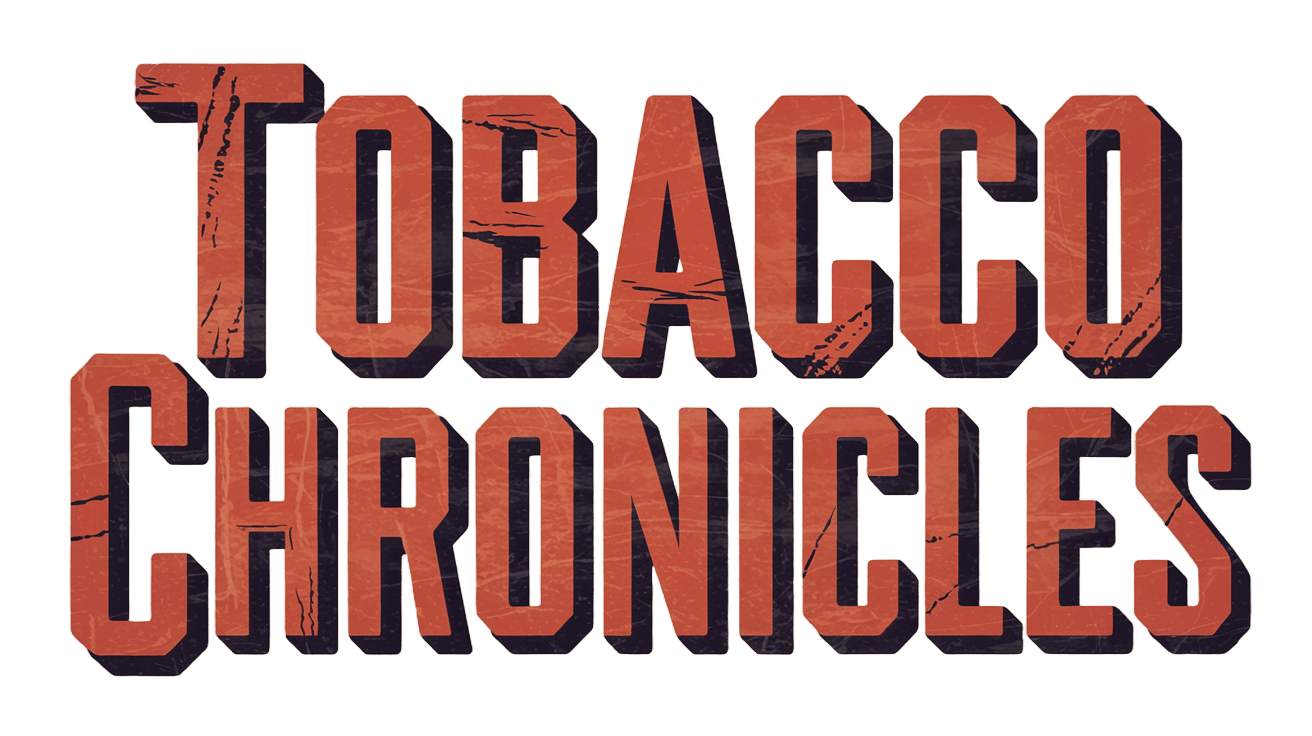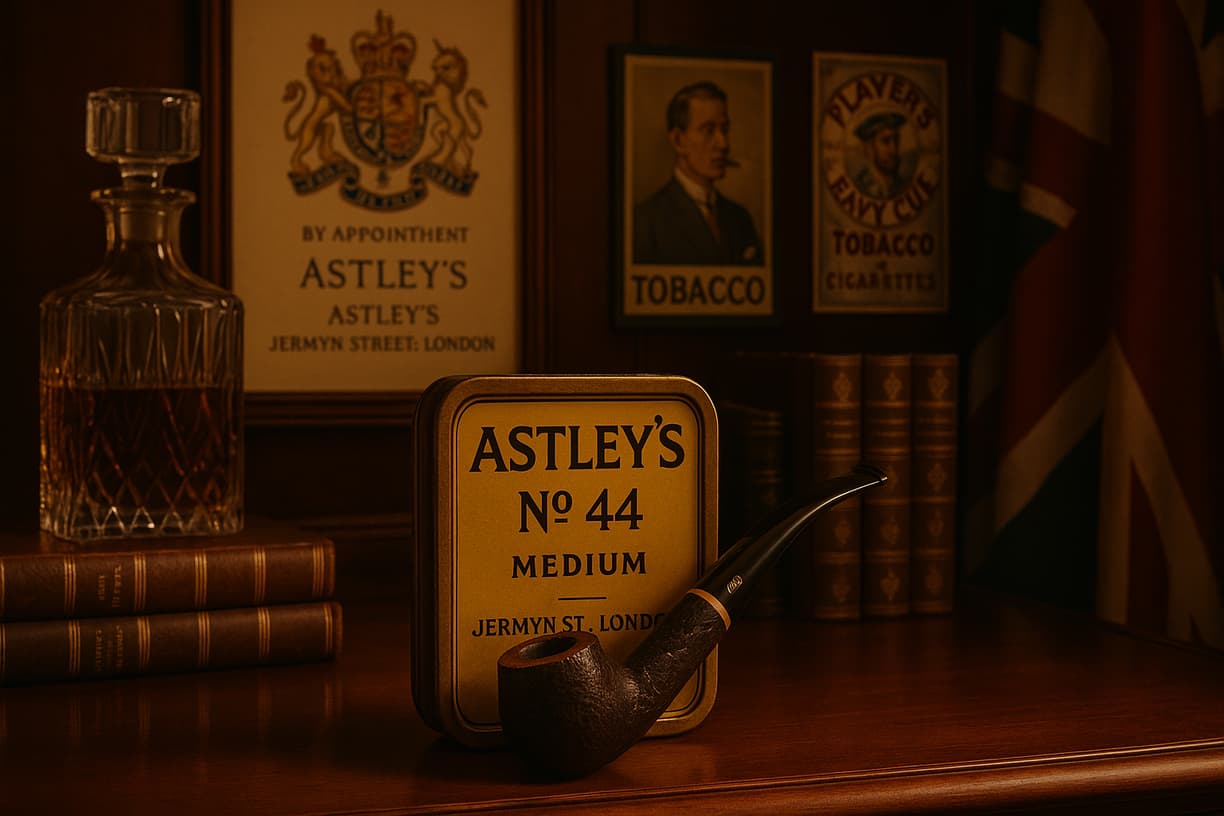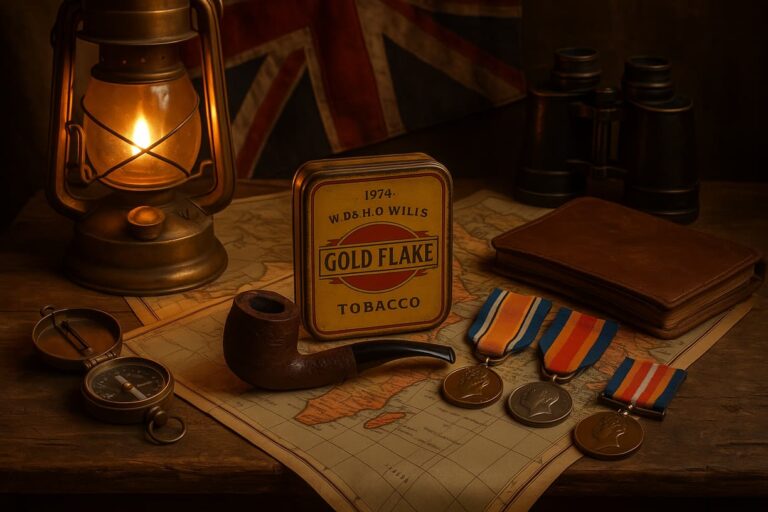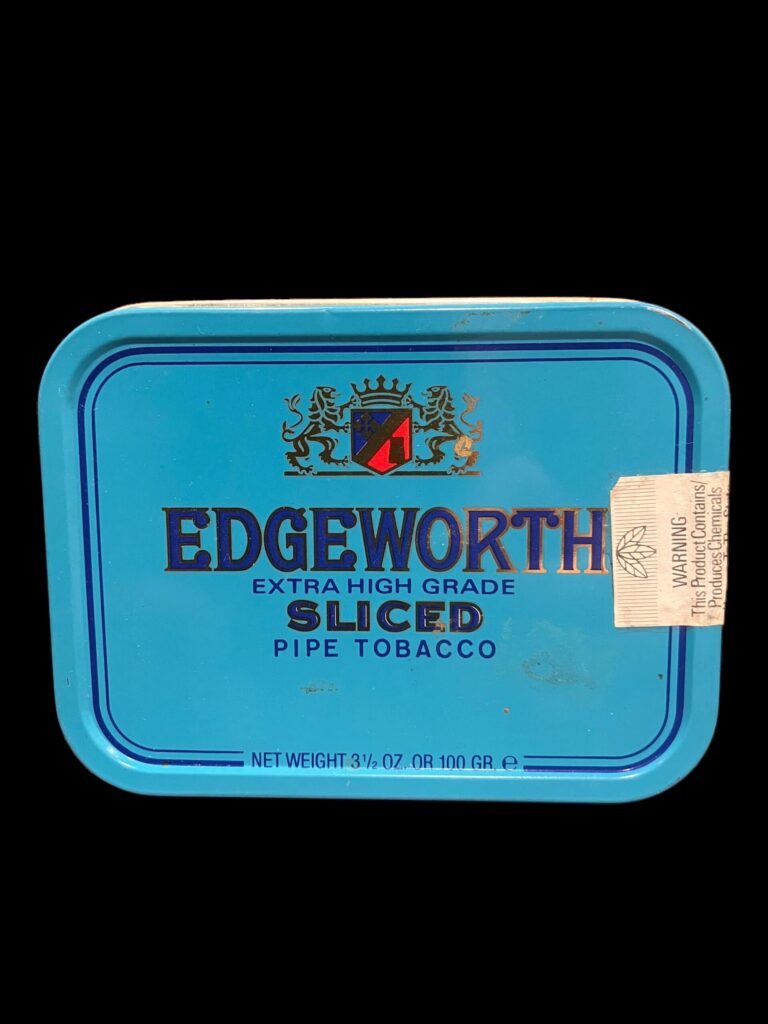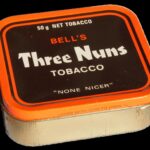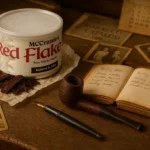“There was a time when Virginia tobacco was not a commodity but an art form, not a product but a statement. Astley’s No. 44 reminds us of that lost golden age.”
The Last Aristocrat
The tin before me bears the simple, elegant markings of a bygone era: “Astley’s No. 44 Dark Virginia Flake.” No flashy graphics, no marketing hyperbole—just the understated confidence of a tobacconist that served British royalty and aristocracy from 109 Jermyn Street for over a century. This isn’t just tobacco; it’s a direct connection to an age when Virginia tobacco was crafted for kings, not mass markets.
I acquired this particular specimen—a 1985 vintage tin—from an estate sale in the Cotswolds. The elderly gentleman who parted with it spoke reverently of his father’s weekly pilgrimages to Jermyn Street, where Astley’s staff would personally blend tobacco to individual preferences. “Father always said No. 44 was what the Duke of Windsor smoked,” he told me with a wistful smile. Whether true or apocryphal, the story captures something essential about Astley’s: this was tobacco for those who understood that quality was never negotiable.
Astley’s No. 44 represents the last gasp of an era when Virginia tobacco was synonymous with sophistication rather than simplicity. This wasn’t tobacco designed for the masses or engineered for maximum profit margins. This was tobacco crafted for discerning gentlemen who expected their tobacconist to understand that a Virginia could be both pure and profound, both natural and aristocratic.
The tragedy of modern Virginia tobacco is that it’s forgotten this fundamental truth. Today’s Virginia market treats purity and complexity as mutually exclusive concepts, as if maintaining natural character automatically disqualifies a blend from achieving true sophistication. Astley’s No. 44 proves this false dichotomy wrong, demonstrating that in the hands of master blenders, straight Virginia tobacco could achieve heights of complexity and refinement that put many “enhanced” blends to shame.
The House That Royalty Built
To understand Astley’s No. 44, one must first understand the institution that created it. Astley’s wasn’t just another London tobacconist—it was the tobacconist, the establishment that defined what luxury tobacco could be when craftsmanship mattered more than cost-cutting. Founded in 1862 at 109 Jermyn Street, Astley’s occupied a position in London’s tobacco hierarchy that was both unassailable and uncompromising.
The location itself tells the story. Jermyn Street in the heart of St. James’s was—and remains—the epicenter of British luxury retail. This wasn’t a street for casual browsers or bargain hunters; this was where the aristocracy, the wealthy, and the discerning came to acquire the finest goods money could buy. To maintain a presence on Jermyn Street for over a century required not just financial success but cultural relevance—the kind of reputation that could only be built through generations of uncompromising quality.
Astley’s clientele read like a who’s who of British society. While the shop was discreet about its customers—discretion being a hallmark of true luxury service—whispered stories spoke of royal appointments, diplomatic pouches filled with Astley’s blends, and cabinet ministers who would delay important meetings rather than miss their weekly tobacco consultations. This wasn’t mere commerce; it was cultural stewardship.
The shop’s approach to tobacco was fundamentally different from modern retailers. Astley’s didn’t simply sell tobacco; they curated experiences. Each blend was crafted with the understanding that it would be consumed by individuals who had access to the finest things in life and who would immediately recognize inferior quality. The pressure to maintain standards wasn’t commercial—it was cultural. To disappoint an Astley’s customer wasn’t just to lose a sale; it was to betray a tradition.
This cultural context is essential to understanding No. 44. This wasn’t tobacco created in a laboratory or focus-grouped for mass appeal. This was tobacco crafted by artisans who understood that their work would be judged by the most sophisticated palates in the Empire. The result was a blend that achieved something modern Virginias have largely forgotten: the ability to be both immediately accessible and endlessly complex.
The Alchemy of Aristocracy
What made Astley’s No. 44 extraordinary wasn’t just its quality—though that was exceptional—but its philosophy. This was straight Virginia tobacco created without apology, without compromise, and without the defensive posturing that characterizes so many modern attempts at “sophisticated” Virginias. The blenders at Astley’s understood that sophistication didn’t require artificial enhancement; it required the mastery of natural tobacco character.
The foundation of No. 44 was built on Virginia tobacco of exceptional quality. This wasn’t the bright, one-dimensional Virginia found in many modern blends, but mature, complex leaf that had been carefully selected and aged to develop the kind of depth and character that only time can create. The Virginia component provided not just sweetness but structure—a solid foundation that could stand on its own merits without requiring enhancement or support from other tobacco types.
The processing applied to No. 44 was a masterclass in restraint and sophistication. Where modern Virginias often rely on quick processing and immediate availability, Astley’s approach was patient and nuanced. The tobacco was pressed into flakes and allowed to marry and develop, creating a harmony within the Virginia leaf that spoke to generations of processing expertise.
The specific nature of the Virginia selection has been the subject of much speculation among enthusiasts. Some detect notes of citrus—orange zest and lemon—while others identify darker, more complex elements like dark fruit, earth, and natural tobacco sweetness. The truth is likely that the blend represented a carefully guarded selection of Virginia grades, developed over decades of experimentation and refinement to achieve the perfect balance between brightness and depth.
What sets No. 44 apart from modern Virginias is the integration of these natural elements. Rather than presenting a single-note Virginia character, No. 44 reveals layers of complexity that emerge from within the leaf itself, as if the Virginia had naturally developed these complex flavors through careful selection and patient aging. This seamless integration is the hallmark of master blending—the ability to create something that seems effortless but requires extraordinary skill to achieve.
The flake format of No. 44 also contributed to its exceptional character. The pressing process allowed the various Virginia grades to marry and integrate, creating a more thorough melding than would be possible with loose-cut blends. The result was tobacco that maintained its complex character throughout the entire smoking experience, rather than losing its depth as the bowl progressed.
The Ritual of Refinement
Opening a 38-year-old tin of Astley’s No. 44 is an exercise in anticipation and reverence. The seal breaks with the satisfying pop that only quality tins provide, releasing an aroma that immediately transports me to another era. This isn’t the harsh, one-dimensional brightness that characterizes many modern Virginias. Instead, it’s a complex bouquet that speaks to careful craftsmanship and premium leaf selection.
The tin note reveals layers of complexity that unfold gradually. The initial impression is one of refined Virginia character—not the sharp, acidic brightness of modern processing, but something altogether more sophisticated and natural. There are notes of citrus zest, but they’re balanced by deeper, richer elements that suggest dark fruits, earth, and that distinctive quality that separates truly great Virginia from the merely good. The Virginia base is clearly present, providing a foundation of natural tobacco sweetness that speaks to careful leaf selection and patient aging.
The flakes themselves tell a story of quality and craftsmanship. They’re uniformly pressed and colored, with the rich, dark brown hue that indicates proper aging and careful handling. The texture is perfect—firm enough to hold together when handled, but yielding enough to rub out easily when prepared for smoking. Even the visual presentation speaks to the attention to detail that characterized Astley’s approach to tobacco.
I select my Comoy’s Blue Riband straight grain billiard for this momentous occasion—a pipe that seems appropriate for such distinguished tobacco. The preparation process reveals the blend’s exceptional quality; the flakes rub out to a perfect consistency with minimal effort, and the resulting mixture packs easily and evenly in the bowl. Even the act of preparation feels ceremonial, as if I’m participating in a ritual that connects me to generations of discerning smokers.
The loading process showcases the blend’s superior engineering. The tobacco accepts flame readily but burns slowly and evenly, with none of the hot spots or irregular burning that can plague lesser blends. The draw is perfect—neither too tight nor too loose—indicating the kind of careful attention to cut and moisture content that characterized quality tobacco of this era.
The Smoking Experience: Sophistication Realized
The first light of Astley’s No. 44 is a revelation that immediately distinguishes it from every modern Virginia I’ve encountered. This is tobacco smoking as it was meant to be—not the simplified, one-dimensional experience of contemporary blends, but a complex journey that rewards attention and contemplation. The initial flavors are dominated by the Virginia character, but this isn’t the harsh, acidic assault that characterizes so many modern attempts at straight Virginia tobacco.
What strikes me immediately is the blend’s sophistication and restraint. The Virginia character is clearly present and beautifully developed, but it never overwhelms with harshness or bite. Instead, it presents a harmony of natural tobacco flavors that speaks to the skill of the original blenders. This is Virginia tobacco for adults—complex, nuanced, and utterly without apology for its natural character.
The citrus notes that were apparent in the tin aroma translate beautifully to the smoking experience. There’s a bright, zesty quality that adds liveliness to the blend without becoming sharp or harsh. These citrus elements are supported by deeper, richer flavors that suggest dark fruits, earth, and that distinctive Virginia sweetness that only comes from properly aged leaf. The overall effect is one of sophisticated complexity—flavors that complement rather than compete with each other.
As the bowl progresses, the Virginia character begins to reveal additional layers of complexity, but even here the integration remains seamless. The natural sweetness of the Virginia tobacco provides a constant foundation, while deeper, more complex flavors emerge and develop. This is tobacco that rewards slow, contemplative smoking—each puff reveals new nuances and subtleties.
The middle portion of the bowl showcases the true genius of No. 44. The Virginia character continues to evolve and develop, revealing layers of complexity that weren’t apparent in the initial lighting. The citrus notes become more mellow and integrated, while the darker, richer flavors gain prominence. The natural tobacco sweetness provides a constant thread that ties everything together.
What separates No. 44 from modern Virginias becomes increasingly clear as the smoking experience progresses. Where contemporary Virginia tobaccos often become harsh or one-dimensional as the bowl burns down, No. 44 maintains its complex profile throughout the entire experience. The various Virginia grades don’t simply burn away; they’re integrated throughout the blend, ensuring that the complex character persists from first light to final puff.
The final third of the bowl demonstrates the blend’s exceptional aging potential. Rather than becoming harsh or bitter as many tobaccos do when burned down, No. 44 actually improves, concentrating its flavors while maintaining the smooth, cool character that has defined the entire experience. The Virginia character remains present and pleasant, while the natural tobacco sweetness provides a satisfying conclusion to the smoking experience.
Throughout the entire bowl, the smoke remains cool and smooth, with none of the bite or harshness that can plague lesser Virginia blends. The room note is pleasant and sophisticated—the kind of aroma that enhances rather than dominates a space. This is tobacco that could be smoked in the finest drawing rooms without causing offense, yet complex enough to satisfy the most demanding connoisseur.
The Philosophy of Purity
Smoking Astley’s No. 44 is more than just a tobacco experience—it’s a lesson in what happens when master craftsmen are given the freedom to pursue excellence without compromise. This blend represents a completely different philosophy from modern tobacco production, one that prioritized quality over quantity, sophistication over mass appeal, and craftsmanship over cost-cutting.
The blend’s straight Virginia character represents a fundamental challenge to contemporary assumptions about “complex” tobacco. In today’s pipe smoking culture, there’s an unfortunate tendency to treat straight Virginia tobacco as somehow simple or less sophisticated than blended tobaccos. No. 44 proves this prejudice wrong, demonstrating that in the hands of master blenders, straight Virginia tobacco could achieve levels of complexity and refinement that rival any blend ever created.
This approach required not just superior ingredients but also superior knowledge and patience. The blenders who created No. 44 possessed an intuitive understanding of how different Virginia grades interact and develop, and they had the skill to create compositions that enhanced the natural tobacco character rather than masking it. They understood that the goal wasn’t to create tobacco that tasted like something else, but to create tobacco that tasted like the best possible version of itself.
The economic reality of No. 44’s era also played a crucial role in its excellence. In the mid-20th century, luxury tobacco companies could afford to use premium ingredients and time-intensive processes because their clientele was willing to pay for quality. The customers who frequented Astley’s weren’t looking for bargains; they were seeking the finest tobacco money could buy, and they were willing to pay accordingly.
This economic model allowed for approaches to tobacco blending that are simply impossible in today’s cost-conscious market. The Virginia tobacco used in No. 44 was likely aged for years before blending, and the various grades were probably sourced from premium suppliers who specialized in quality leaf. The pressing and aging process added additional time and cost, but the result was tobacco that justified its premium price through superior quality.
The Tragedy of Progress
The disappearance of blends like Astley’s No. 44 represents more than just the loss of a single tobacco—it symbolizes the death of an entire approach to Virginia tobacco craftsmanship. The modern tobacco industry, driven by efficiency and cost-cutting, has largely abandoned the complex, time-intensive processes that created blends like No. 44.
The closure of Astley’s in 1998 marked the end of an era in London tobacco retail. When Paul Bentley moved the shop from its historic Jermyn Street location to Piccadilly Arcade, something essential was lost. The new location lacked the cultural weight and historical significance of the original shop, and the clientele that had sustained Astley’s for over a century began to drift away. The final closure represented not just the end of a business, but the end of a tradition.
The modern Virginia tobacco market operates under completely different assumptions from those that created No. 44. Contemporary manufacturers treat Virginia tobacco as a basic component designed to provide sweetness and body rather than complexity and sophistication. The result is tobacco that prioritizes immediate accessibility over long-term satisfaction, simple character over natural complexity.
This transformation reflects broader cultural changes in how we approach luxury and craftsmanship. We live in an age where everything must be faster, cheaper, and more accessible, but in the process, we’ve lost the patience and appreciation for the kind of slow, careful work that created blends like No. 44. The modern consumer expects instant gratification, but tobacco like No. 44 required time—time to age, time to blend, time to appreciate.
The loss of institutional knowledge has been equally devastating. The master blenders who created No. 44 possessed skills that were passed down through generations of craftsmen, but when companies like Astley’s disappeared, that knowledge disappeared with them. Modern tobacco companies may have access to better technology and more efficient processes, but they lack the accumulated wisdom that created the great blends of the past.
The Aristocrat’s Legacy
What made Astley’s No. 44 truly special wasn’t just its quality—though that was exceptional—but its confidence. This was tobacco that made no apologies for its Virginia character, no concessions to contemporary prejudices about “simple” tobacco. It was what it was—sophisticated, complex, straight Virginia tobacco created for discerning smokers who understood that purity and refinement were not mutually exclusive concepts.
The blend’s aristocratic heritage is evident in every aspect of its character. From the careful selection of premium Virginia tobacco to the sophisticated processing and aging, every decision reflected the understanding that this tobacco would be consumed by individuals who had access to the finest things in life. There was no room for compromise, no tolerance for inferior quality.
This aristocratic approach extended beyond just the tobacco itself to the entire experience of acquiring and consuming it. Purchasing tobacco from Astley’s wasn’t just a transaction; it was a cultural experience that connected the customer to a tradition of excellence that stretched back generations. The staff understood that they weren’t just selling tobacco; they were maintaining a standard of quality that reflected on the entire institution.
The legacy of No. 44 extends beyond its immediate smoking qualities to its demonstration of what Virginia tobacco could achieve when created without compromise. In an era when Virginia tobacco is often dismissed as simple or one-dimensional, No. 44 stands as proof that such prejudices are unfounded. In the hands of master craftsmen, Virginia tobacco could achieve levels of complexity and refinement that rival any blend ever created.
The Verdict: Excellence Remembered
Astley’s No. 44 represents the absolute pinnacle of what Virginia tobacco could achieve when master blenders were given the freedom to pursue excellence without compromise. This wasn’t just straight tobacco—it was a sophisticated composition that demonstrated the highest levels of blending artistry while maintaining an unapologetically Virginia character.
The blend’s Virginia foundation showcased the kind of careful tobacco selection and aging that characterized quality tobacco of its era, while the processing demonstrated that purity and sophistication were not mutually exclusive concepts. The result was a smoking experience that was both immediately appealing and endlessly complex—tobacco that could satisfy both the casual smoker and the most demanding connoisseur.
For those fortunate enough to encounter an authentic tin of Astley’s No. 44, the experience is both a privilege and a reminder of what we’ve lost. It’s a privilege to taste what Virginia tobacco was capable of achieving at its absolute peak, but it’s also a reminder that such artistry has been largely abandoned in favor of efficiency and cost-cutting.
The modern tobacco industry has given us convenience, consistency, and accessibility, but it has taken away the magic that made blends like No. 44 legendary. While the blend continues to be produced today by Kohlhase & Kopp, maintaining the traditional recipe and quality standards, the cultural context that created it—the aristocratic clientele, the Jermyn Street heritage, the personal service—can never be fully recreated. We can appreciate what remains, we can celebrate what we have, but the original Astley’s experience died with the closure of 109 Jermyn Street.
This single tin of 38-year-old tobacco has been worth more than cases of modern Virginias. It has reminded me why serious pipe smokers once spoke of Astley’s with the same reverence reserved for the finest wines or spirits, and it has shown me what we lost when the tobacco industry chose efficiency over excellence.
Astley’s No. 44 wasn’t just Virginia tobacco—it was Virginia tobacco elevated to the level of art. It was tobacco created for kings and consumed by aristocrats, yet accessible to anyone who understood that quality was never negotiable. It was a reminder that in the hands of master craftsmen, even the most humble leaf could be transformed into something approaching perfection.
Rating: ★★★★★ (5/5 stars)
Availability: Currently Available
Original Manufacturer: Astley’s of 109 Jermyn Street, London (1862-1998)
Current Manufacturer: Kohlhase & Kopp
Blend Type: Straight Dark Virginia Flake
Primary Components: Dark Virginia tobacco
Strength: Medium
Character: Sophisticated, refined, aristocratic Virginia
Aging Potential: Exceptional (as evidenced by this 38-year-old specimen)
Heritage: Served British royalty and aristocracy since 1862
Some tobaccos are discontinued. Others become legend. Astley’s No. 44 transcended both categories to become a reminder of what Virginia tobacco could achieve when craftsmanship mattered more than cost-cutting, and when blenders understood that their job was to create not just tobacco, but experiences worthy of kings.
